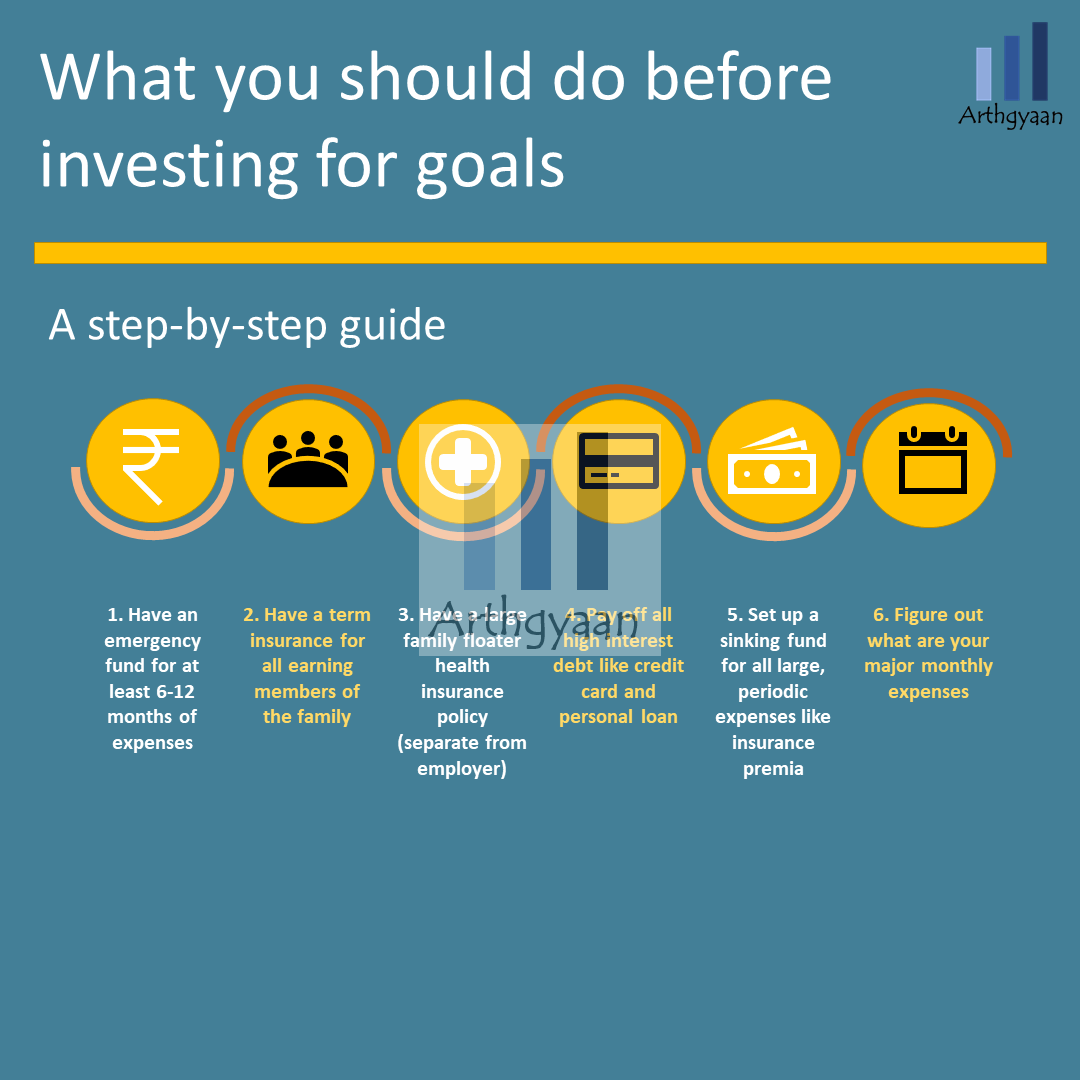I have heard of goal-based investing. What now?
Part 2: As someone who has heard about goal-based investing, how do I get started?
Part 2: As someone who has heard about goal-based investing, how do I get started?

Click to read the other parts:
You have now heard of goal-based investing and the basic money equation: Income = Expenses + Investments. This post builds on what is needed next before you actually get started with goal-based investing.
This is needed to pay for sudden or unplanned expenditures like medical emergencies, job loss etc and lets you sleep well at night knowing this money is there. For this, you should save 3-12 times your monthly expenses (not Income) in a savings A/C with Sweep FD / bank Fixed deposit (FD) / recurring deposit (RD) and refill the fund once the emergency has passed. Here are more details on the emergency fund.
This allows you to safeguard your future earnings at the cheapest possible cost. Try to get coverage amount is a multiple (15-20x) of current post-tax annual income and take the annual premium (once-a-year) payment option from an insurer you are comfortable with. The premium can be saved via a sinking fund (see below). Here is an article that deals with buying term insurance step-by-step.
Health insurance costs are relatively cheap at the beginning of the career so this is a good time to take a family floater coverage (separate from the company-provided one if any) for ₹10-15 lakhs base policy with a ₹50-100 lakhs super-top up. Elderly parents must be covered in a separate policy since due to co-morbidities, their premiums will increase drastically a few years later. The premium, since health insurance can be expensive, can be saved via a sinking fund.
The purpose of the personal accident (PA) insurance policy is to provide a replacement for your income if you have an accident and cannot work after that. Unlike term insurance, where claims are paid on death, a PA cover is applicable when one of the following is the result of an accident:
Any loan like a credit card or personal loan comes under this bracket. If any extra money is there, then it is always best to pay off the highest interest rate loan first. This will save a lot of money for future investments. If there is a lot of credit card debt, try to consolidate them via a personal loan at a cheaper rate. Typically, home and education loan is at cheaper rates and can be considered separately.
These are known expenses that are usually mandatory (car/life/health insurance payments) but a few of them can be discretionary as well (like mobile phone replacement, festival trips/shopping). The key here is that the expense is periodic at a frequency lower than once a month. Save 1/12th of the annual expense every month (in the same way as the emergency fund but in a different account/folio) and this will smooth out your monthly expenses as well say pay for large annual expenses like insurance premiums. A detailed article on the sinking fund is here.
To move on to the next step i.e. how much you can invest for goals (the investible surplus) you need to classify and figure out approximately the major monthly expense heads under the 3 main buckets below:
Whatever is remaining after the three cost heads above go into the investible surplus to be used for goal-based investing to be covered in Part 3 of this series. This flips the basic money equation from Income = Expenses + Investments to
Income - Investments = Expenses
Just like a loan EMI gets deducted at the beginning of the month, so the money being invested for goals gets taken out of the salary first and then whatever is remaining is spent. We have covered this concept in detail: How to budget, save and invest in a stress-free manner?.
Get a credit card: The right reason to get a credit card is to build a credit history. Take a simple card, put a small amount in it like mobile/electricity/Netflix and auto-pay that. If you get rejected, many banks give a card against FD which is a good option for first-time applicants. Once you have a good credit history, you will get loans like home loans etc at good rates. Credit cards also can be used in emergencies provided you have money from other assets to pay off the balance. ALWAYS pay off the balance in full since interest rates are very high.
Get KYC done: Mutual fund investments require Know-Your-Client (KYC) to be completed first. This is nowadays online and the mandatory in-person-verification step can be done via video call also. Once done it can be used to invest in any mutual fund.
Part 3 of the series: Part 3: I am now ready to do goal-based investing, how do I get started?.

Published: 18 December 2025
7 MIN READ
1. Email me with any questions.
2. Use our goal-based investing template to prepare a financial plan for yourself.Don't forget to share this article on WhatsApp or Twitter or post this to Facebook.
Discuss this post with us via Facebook or get regular bite-sized updates on Twitter.
More posts...Disclaimer: Content on this site is for educational purpose only and is not financial advice. Nothing on this site should be construed as an offer or recommendation to buy/sell any financial product or service. Please consult a registered investment advisor before making any investments.
This post titled I have heard of goal-based investing. What now? first appeared on 29 Mar 2021 at https://arthgyaan.com